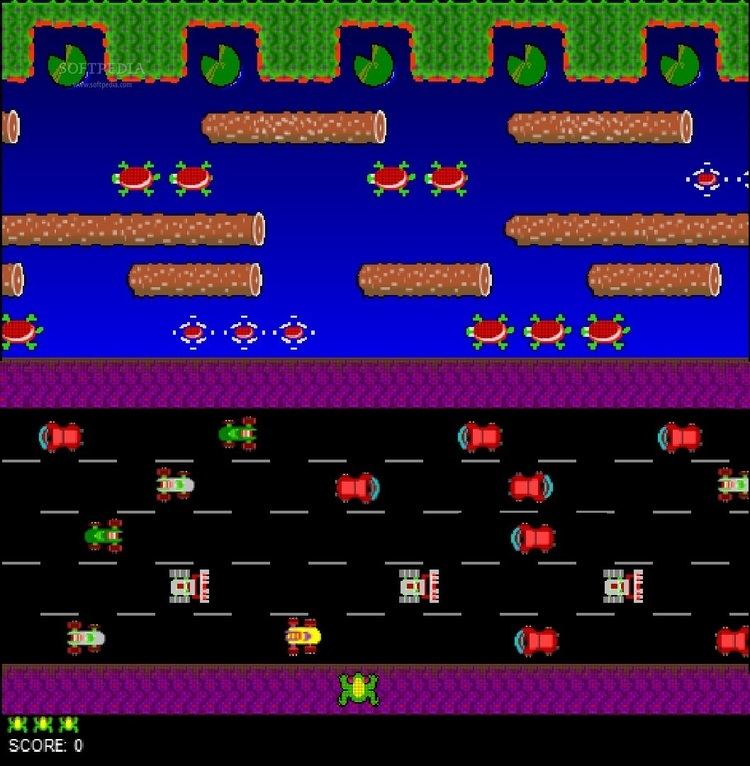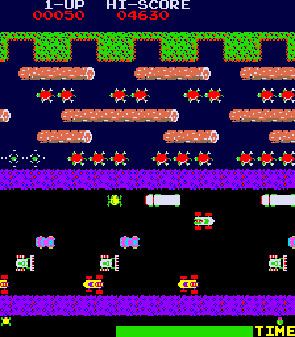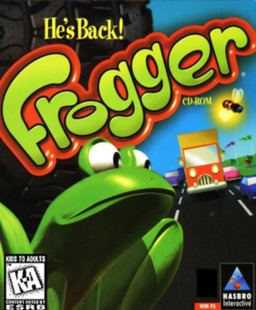Genre(s) Overhead view action Initial release date 1981 | Series Frogger Cabinet Upright Sound Zilog Z80 | |
 | ||
Mode(s) Up to 2 players, alternating turns CPU 2x Z80:Z80 (@ 3.072 MHz)Z80 (@ 1.78975 MHz) Similar Sega games, Other games | ||
Arcade game frogger 1981 konami
Frogger (フロッガー (Furoggā)) is a 1981 arcade game developed by Konami. It was licensed for North American distribution by Sega-Gremlin and worldwide by Sega itself. It is regarded as a classic from the golden age of video arcade games, noted for its novel gameplay and theme. The object of the game is to direct frogs to their homes one by one by crossing a busy road and navigating a river full of hazards. The Frogger arcade ("coin-op") version is an early example of a game with more than one CPU, as it used two Z80 processors.
Contents
- Arcade game frogger 1981 konami
- Frogger arcade game
- Gameplay Arcade version
- Scoring
- Legacy
- Ports
- Clones
- Sequels
- In film and television
- In music
- Other
- Highest score
- References
By 2005, Frogger in its various home video game incarnations had sold 20 million copies worldwide, including 5 million in the United States.

Frogger arcade game
Gameplay (Arcade version)

The game starts with three, five, or seven frogs (lives), depending on the settings used by the operator. The player guides a frog which starts at the bottom of the screen, to his home in one of 5 slots at the top of the screen. The lower half of the screen contains a road with motor vehicles, which in various versions include cars, trucks, buses, dune buggies, bulldozers, vans, taxis, bicyclists, and/or motorcycles, speeding along it horizontally. The upper half of the screen consists of a river with logs, alligators, and turtles, all moving horizontally across the screen. The very top of the screen contains five "frog homes" which are the destinations for each frog. Every level is timed (1 minute); the player must act quickly to finish each level before the time expires.

The only player control is the 4 direction joystick used to navigate the frog; each push in a direction causes the frog to hop once in that direction. On the bottom half of the screen, the player must successfully guide the frog between opposing lanes of trucks, cars, and other vehicles, to avoid becoming roadkill.
The middle of the screen, after the road, contains a median where the player must prepare to navigate the river.

By jumping on swiftly moving logs and the backs of turtles and alligators except the alligator jaws, the player can guide his or her frog safely to one of the empty lily pads. The player must avoid alligators sticking out at one of the five "frog homes", snakes, and otters in the river, but may catch bugs or escort a lady frog for bonuses. When all five frogs are directed home, the game progresses to the next level, with increased difficulty. After five levels, the game gets briefly easier yet again gets progressively harder to the next fifth level.
Softline in 1982 stated that "Frogger has earned the ominous distinction of being 'the arcade game with the most ways to die'". There are many different ways to lose a life (illustrated by a "skull and crossbones" symbol where the frog was), including:
- Being hit by or running into a road vehicle
- Jumping into the river's water
- Running into snakes, otters or into an alligator's jaws in the river
- Jumping into a home invaded by an alligator
- Staying on top of a diving turtle until it has completely submerged
- Riding a log, alligator, or turtle off the side of the screen
- Jumping into a home already occupied by a frog
- Jumping into the side of a home or the bush
- Running out of time
Frogger is available as a standard upright or cocktail cabinet. The controls consist solely of a 4-direction joystick used to guide the frog's jump direction. The number of simultaneous players is one, and the game has a maximum of two players.
The game's opening tune is the first verse of a Japanese children's song called Inu No Omawarisan (The Dog Policeman). The song remained intact in the US release. Other Japanese tunes that are played during gameplay include the themes to the anime Hana no Ko Lunlun and Araiguma Rascal. The US release also has "Yankee Doodle Dandy".
Scoring
Players earn an extra life at 10,000 or 20,000 points, and none thereafter. Ofttimes, no extra lives.
Legacy
In addition to inspiring numerous clones, this game inspired an unofficial sequel by Sega in 1991 called Ribbit which featured improved graphics and simultaneous two-player action. In 2013, Entertainment Weekly named Frogger one of the top ten games for the Atari 2600.
Ports
Frogger was ported to many contemporary home systems. Parker Brothers received the license from Sega for cartridge versions, while Sierra gained the magnetic media rights. Several platforms were capable of accepting both ROM cartridges and magnetic media, so those systems, such as the Commodore 64, received multiple versions of the game. Sierra also sublicensed their magnetic-media rights to developers who published for systems not normally supported by Sierra (e.g. Cornsoft published the official TRS-80/Dragon 32, Timex Sinclair 1000 and Timex Sinclair 2068 ports). Because of that, even the Atari 2600 received multiple releases: a cartridge from Parker Bros. and a cassette for the Supercharger from Starpath. The Tomy Tutor version was directly licensed from Konami itself, although it is not clear if Tomy further developed it.
Parker Brothers produced cartridge ports of Frogger for the Atari 2600, Intellivision, Atari 5200, ColecoVision, Atari 8-bit computers, Commodore VIC-20 and 64. Sierra released disk and/or tape ports for the C64 (which, as a result, ended up with two versions of the game), Apple II, the original 128k Macintosh, IBM PC, Atari 2600 Supercharger, as well as the above-mentioned versions for the TRS-80 Color Computer A version for Sinclair developed by UK-based Cornsoft. Parker Bros. spent $10 million on advertising Frogger, along with The Empire Strikes Back, larger than the $6 million marketing budget for a movie at the time. Parker Brothers sold three million cartridges of both Frogger and The Empire Strikes Back, with Frogger alone being the company's most successful first-year product, beating the sales and revenues of Merlin, its previous best-seller. Coleco also released stand-alone Mini-Arcade tabletop versions of Frogger, which, along with Pac-Man, Galaxian, and Donkey Kong, sold three million units combined.
A prototype game, based on gameplay elements of Frogger, was developed for Sega Game Gear but never released, presumably due to legal disagreement between Sega and Konami. The prototype wasn't a direct port of the arcade game, because it had additional features and redesigned levels.
Hasbro Interactive released a vastly expanded remake of the original for Microsoft Windows and the PlayStation in 1997 (in this game, Frogger is green with an orange stripe). Unlike the original, the game consisted of multiple levels, each different than the preceding one. It was a commercial success, with the PC version alone selling nearly one million units in less than four months.
In 1998, Hasbro released a series of ports of the original game for the Sega Genesis, Super NES, Game com, Game Boy, and Game Boy Color. Each port featured the game with different graphics, with the Sega Genesis port in particular featuring the same graphics of the original arcade game. The Sega Genesis and SNES versions are notable for both being the last games released for those consoles in North America. Despite using the same box art of the 1997 remake, the ports are otherwise unrelated to that game.
In 2005, InfoSpace teamed up with Konami Digital Entertainment to create the mobile game Frogger for Prizes, in which players across the U.S. compete in multiplayer tournaments to win daily and weekly prizes. In 2006, the mobile game version of Frogger grossed over $10 million in the United States. A Java port of the game is available for compatible mobile phones.
A port of Frogger was released on the Xbox Live Arcade for the Xbox 360 on July 12, 2006. It was developed by Digital Eclipse and published by Konami. It has two new gameplay modes: Versus speed mode and Co-op play. Some of the music, including the familiar Frogger theme, was removed from this version and replaced with other music. This version was included in the compilation Konami Classics Vol. 1.
Clones
Unofficial clones include Ribbit for the Apple II (1981), Acornsoft's Hopper (1983) for the BBC Micro and Acorn Electron, A&F Software's Frogger (1983) for BBC Micro and ZX Spectrum, Froggy for the ZX Spectrum released by DJL Software (1984), Solo Software's Frogger for the Sharp MZ-700 in the UK (1984), and a version for the NewBrain under the name Leap Frog.
The Atari 2600 game Freeway is often considered a clone of Frogger, but each game was developed independently of the other, and both were released in 1981.
Pacific Coast Highway (1982), for the Atari 8-bit family, splits the gameplay into two alternating screens: one for the highway, one for the water.
Preppie! (1982), for the Atari 8-bit family, changes the frog to a preppy retrieving golf balls at a country club.
Frostbite (1983), for the Atari 2600, uses the Frogger river gameplay with an arctic theme.
Crossy Road (2014), for iOS, Android and Windows Phone, has a randomly generated series of road and river sections. The game is one endless level, with only one life and a single point given for each forward hop
In 2008, the City of Melbourne created a spin-off called Grogger as part of a public service campaign to encourage people to take safe transportation home after a night of drinking.
Sequels
Unlike the arcade version, the home versions had numerous sequels, including:
In many of the recent games (starting with Frogger: The Great Quest), Frogger is shown as bipedal, wearing a shirt with a crossed-out truck.
In film and television
In music
Other
Highest score
On July 15, 2012, Michael Smith of Springfield, Virginia, USA, scored a Frogger world record high score of 970,440 points. This beat Pat Laffaye's score of 896,980 from December 22, 2009. These are the only two scores that have been verified as having beaten the fictional George Costanza Seinfeld score of 860,630 points.
